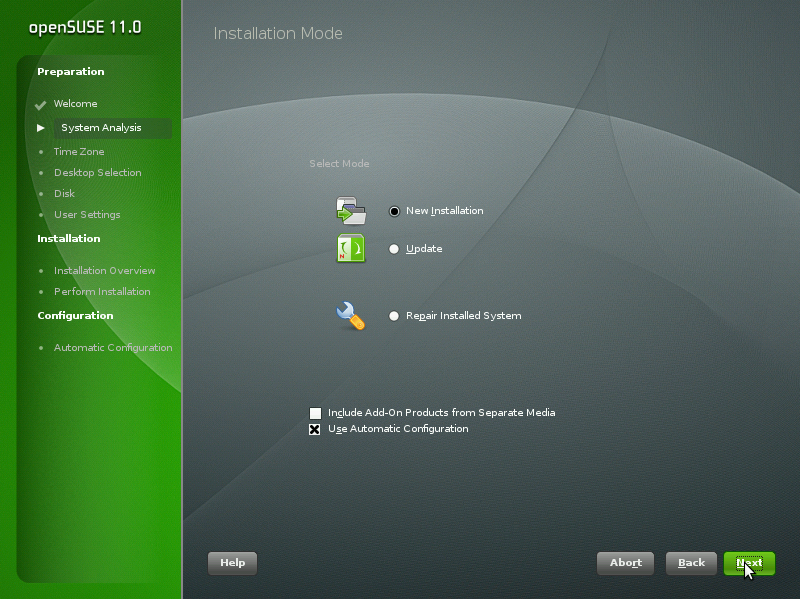1.7 Installation Mode
After a system analysis where YaST probes for storage devices and tries to find other installed systems on your machine, the installation modes available are displayed:
-
Select this option to start a new installation from scratch.
-
Select this option to update to a newer version. For more information about system update, see Section 5.0,
Updating the System and System Changes,
(↑ Reference ). -
Choose this option to repair a damaged system that is already installed.
Figure 1-3 Installation Mode

By default, the is used when performing a new installation. In this mode the system automatically configures your hardware and the network, so the installation is performed with minimal user interaction. If necessary, you can change every configuration that is set up later in the installed system using YaST. In repair mode the automatic configuration attempts to fix errors automatically. Uncheck if you prefer a manual configuration during the installation or to start the system reparation in expert mode.
This screen also offers to include add-on products during the installation. To include such products, check . An add-on product can include proprietary third-party products or additional software for your system such as additional languages or non open source software.
Click to proceed. If you selected to include an add-on product, proceed with Section 1.7.1, Add-On Products, otherwise skip the next section and advance to Section 1.8, Clock and Time Zone.
1.7.1 Add-On Products
Add-on products can be installed either from a local source (CD, DVD, or directory) or from a network source (HTTP, FTP, NFS, CIFS,...). When installing from a network source, you need to configure the network first—unless you are performing a network installation anyway. Choose and proceed as described in Network Setup. If the add-on product is available locally, select .
Click and specify the product source. Source types available are CD, DVD, and a directory if no network was configured. While a network is available, you can chooses from additionl remote sources such as HTTP, SLP, FTP and others. It is also possible to specify a URL directly. Proceed with and insert a CD or DVD if required. Depending on the product's content it may be necessary to accept additional license agreements.
It is also possible to configure add-on products at any time in the installed systems. Using add-on products in the installed system is described in Section 3.6, Installing Add-On Products.
Network Setup
When invoking the network setup, YaST scans for available network cards. If more than one network card is found, you have to choose the card to configure from the list.
If an ethernet network adapter is not already connected, a warning will open. Make sure the network cable is plugged in and choose . In the following dialog the actual network configuration is done. If your network is equipped with a DHCP server, choose . To manually set up the network choose and specify , , , and the .
Some networks require the use of a proxy server to access the Internet. Tick the check box and enter the appropriate specifications. Click to perform the network setup. The installation procedure will continue with the add-on products or repositories setup as described in Section 1.7.1, Add-On Products.